Author: Marshall Schott
Startled by the outcome of my first Short & Shoddy brew, I knew I’d have to try it again on a normal batch size. While unable to determine precisely why so many of the xBmt variables we test produce non-significant results, I often find myself wondering if it has to do with the discrepancy in scale between commercial brewing, where much of we claim to “know” comes from, and homebrewing. Perhaps the fact the first Short & Shoddy batch was less than half the volume of a more typical 5 gallon batch had some impact that mitigated the negative effects of the shitty way I treated it. Or maybe shorter mash and boil lengths, malt and hop freshness, and fining with a bunch of gelatin really don’t matter as much I thought.
Similar to before, the idea to brew Short & Shoddy 2.0 abruptly came to me one recent Saturday afternoon as my wife was heading out “for a couple hours.” Having brewed a 10 gallon xBmt batch the day prior, I wasn’t interested in pulling everything out for another normal brew day, though it was hard to ignore the cries of my recently emptied second chamber. Within minutes, I used BeerSmith to throw together a 5 gallon BIAB SMaSH recipe with a few slight differences from the first. As my wife was backing out of the garage, I set the timer and got to brewing!
Short & Shoddy Batch #2
Recipe Details
| Batch Size | Boil Time | IBU | SRM | Est. OG | Est. FG | ABV |
|---|---|---|---|---|---|---|
| 5.5 gal | 15 min | 42.4 IBUs | 3.5 SRM | 1.050 | 1.012 | 4.9 % |
| Actuals | 1.043 | 1.009 | 4.4 % | |||
Fermentables
| Name | Amount | % |
|---|---|---|
| Pilsner (Weyermann) | 12 lbs | 100 |
Hops
| Name | Amount | Time | Use | Form | Alpha % |
|---|---|---|---|---|---|
| Exp. 06277 | 50 g | 15 min | First Wort | Pellet | 14.9 |
| Exp. 06277 | 30 g | 5 min | Boil | Pellet | 14.9 |
Yeast
| Name | Lab | Attenuation | Temperature |
|---|---|---|---|
| Safale American (US-05) | DCL/Fermentis | 77% | 59°F - 75°F |
Download
| Download this recipe's BeerXML file |
At precisely 10:12 AM, I began collecting the full volume of brewing liquor directly from my tap through a potable water hose. I usually run my water through a carbon filter but forwent this step to increase the shoddiness of my process.
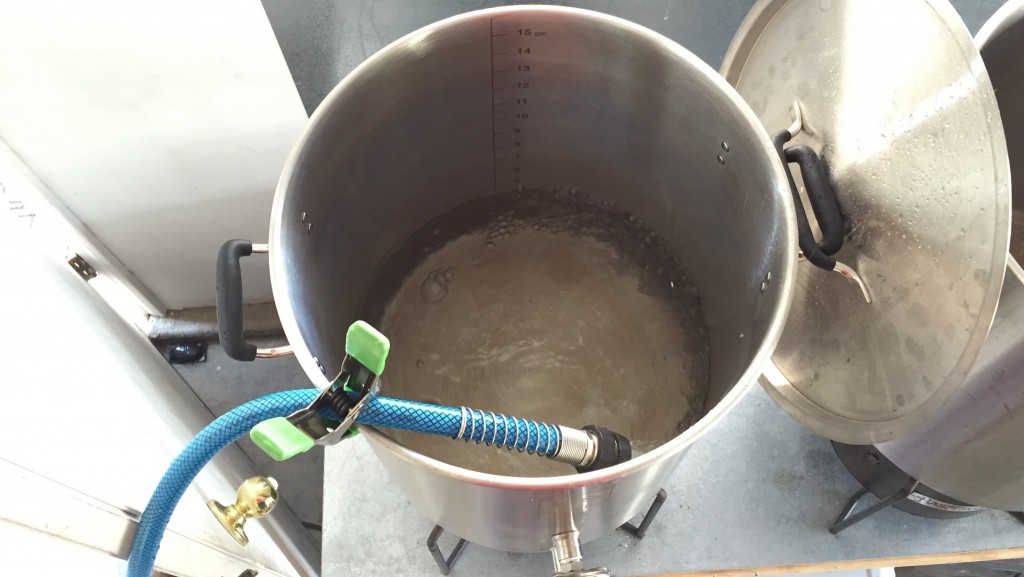
To add to the unpredictability of this batch, I recently learned my tap water at this time was coming from a different source than usual due to the treatment plant being closed for maintenance, meaning nearly double the level of bicarbonate. Thankfully, my municipal water district doesn’t use chloramines and chlorine is mostly undetectable. I emptied a Beer Dust IPA Profile packet I picked up at NHC/HomebrewCon 2015 into the water for curiosity’s sake. It took some time for the water to reach target strike temp due to cooler temps this brew day, so this is when I weighed out and milled the Pilsner malt.
I mashed in at 10:42 AM and stirred well with my ginormous whisk to ensure no dough balls.
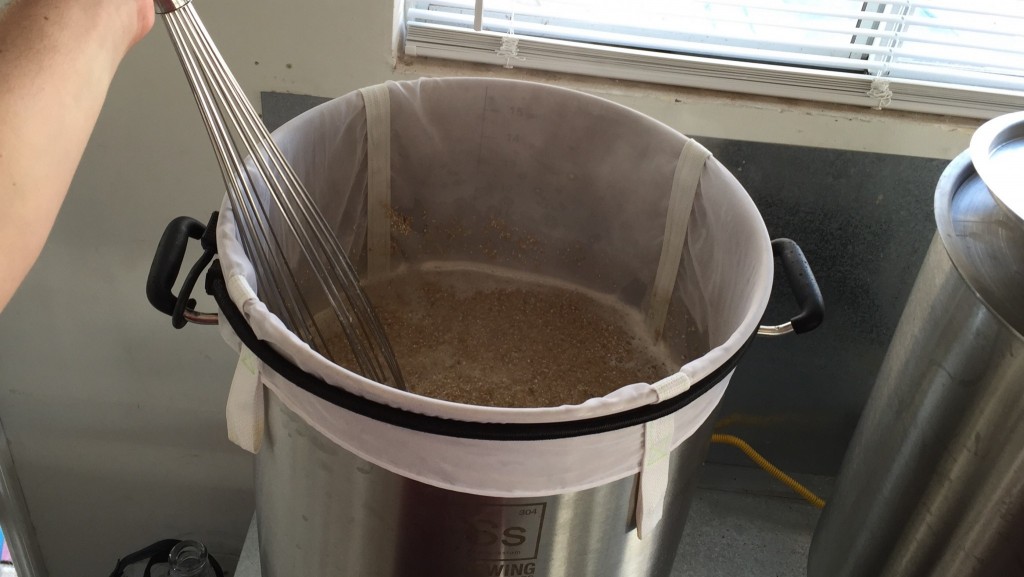
I’m always pleased when math works and I hit my target mash temperature.
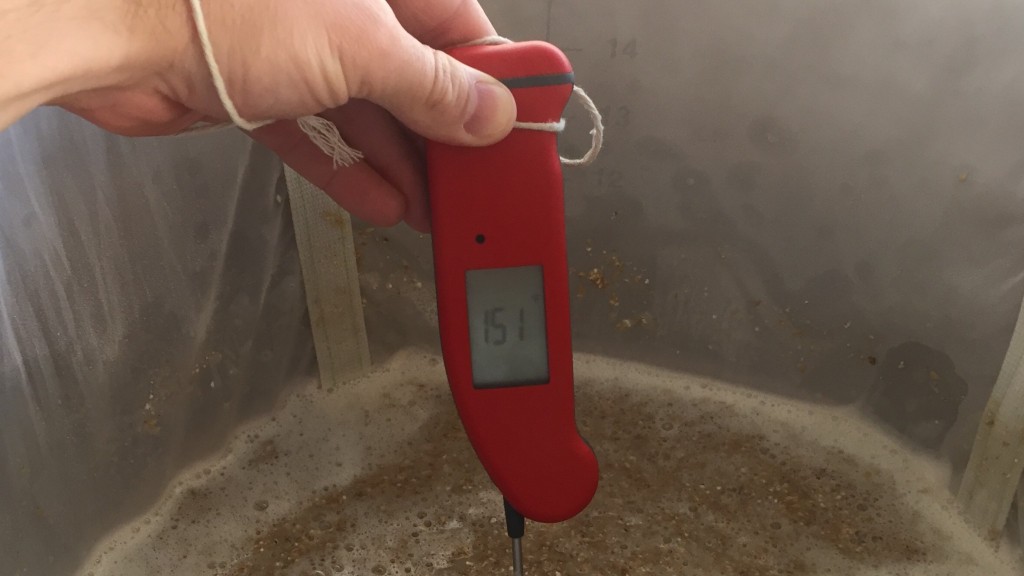
I set a timer for 15 minutes then weighed out the two large additions of Denali hops.
When the timer began beeping, I removed the bag, gave it a good squeeze, hit the flame on my burner, then immediately placed my immersion chiller in the kettle given the short boil. By 11:19 AM, the wort had reached a vigorous boil and I added the first “bittering” hop addition then again set my timer for 15 minutes.
Another hop addition was made during the shortened boil then at 11:34 AM my timer went off. I cut the flame and turned the water to my immersion chiller on. A brief 7 minutes later, the wort had dropped to 72˚F/22˚C, just a few degrees above my groundwater temp. By 11:41 AM I was transferring the wort to a 6 gallon PET carboy.
While the carboy was filling, I stole a small sample from the kettle for a refractometer reading that showed I’d come a bit shy of my expected 1.050 OG, leaving me 8% low on my efficiency. Meh.
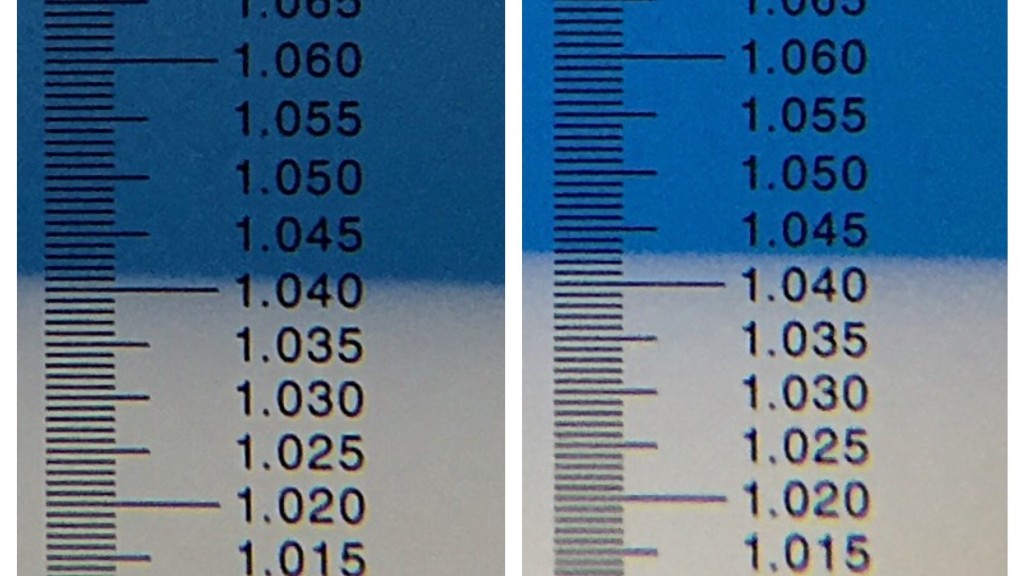
I pitched a single pack of dry Safale US-05 yeast into the wort, it was slightly warmer than I normally prefer, then placed the fermentor in a chamber controlled to 68˚F/20˚C. I cleaned everything up and was completely finished by 11:56 AM, for a total brew day length of 1 hour 44 minutes.
Interestingly, I noticed signs of active fermentation a mere 6 hours after pitching the yeast, perhaps due to the warmer wort temperature. The beer at this point had dropped to my target fermentation temperature.
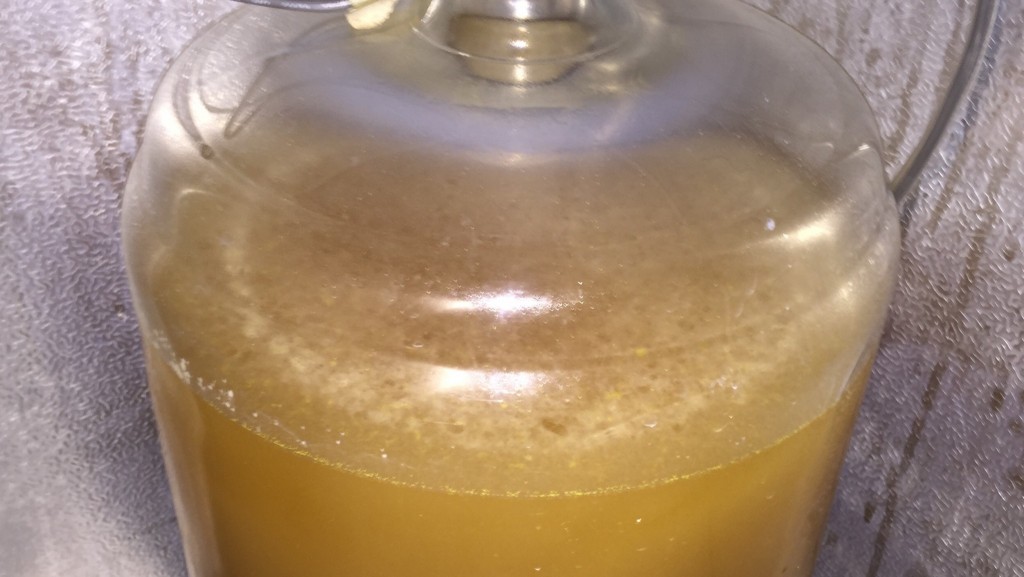
Things were looking pretty normal by the following morning.
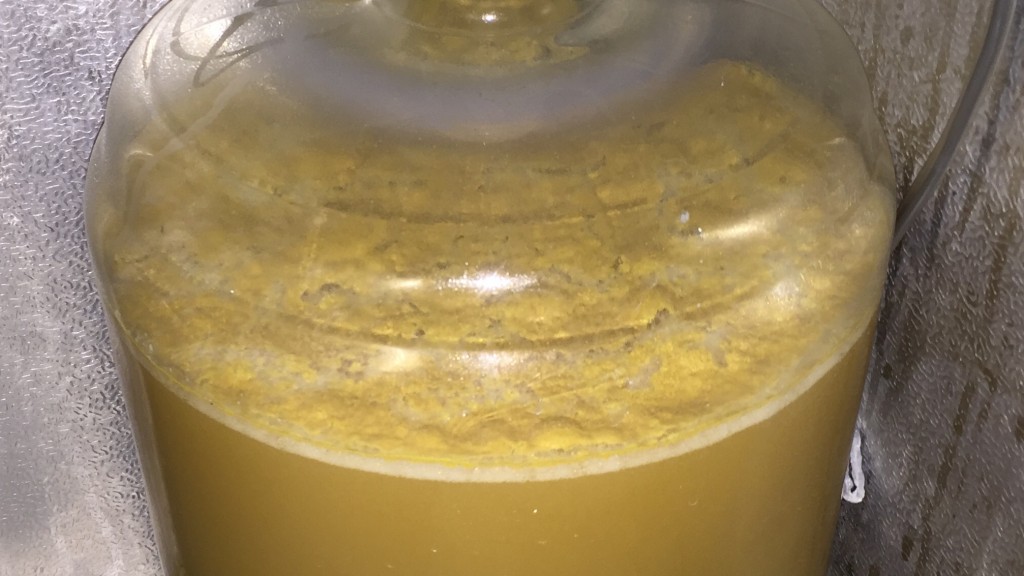
Within a week, activity appeared to have come to a halt, so I took an initial hydrometer reading that matched a reading I took 2 days later.
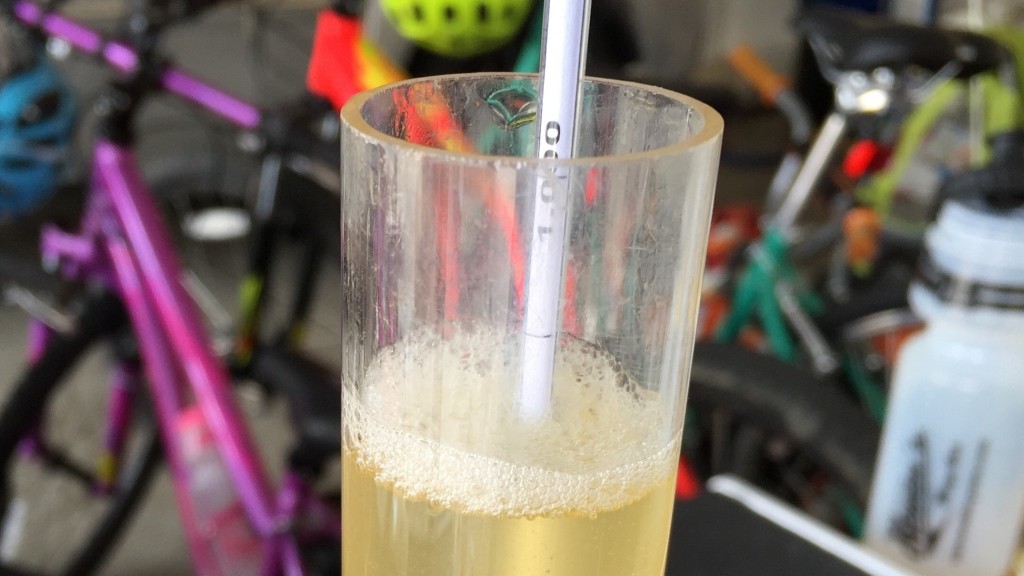
At 1.009 FG, this beer was sitting at 4.4% ABV. I cold crashed it overnight, fined with gelatin, then kegged it a day later, less than 2 weeks from the day it was brewed.
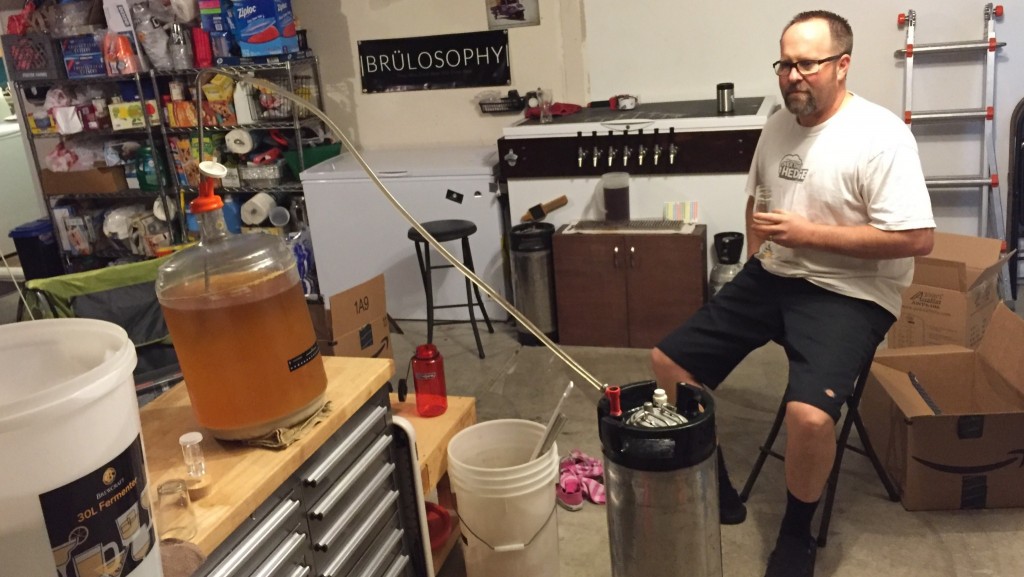
After 24 hours at 45 psi in my 38˚F/3˚C keezer, the beer was well carbonated though maintained a very slight haze that never fully went away.
The time had come to serve this shoddy creation to unsuspecting tasters, folks who had no clue what I was up to.
| IMPRESSIONS |
I sampled and evaluated this beer multiple times before serving it to others, hoping to avoid any influence they might have on my perceptions. Aromatically, I picked up a very strong hop character that matched what I perceived from the THC Denali batch rather well– strong lemony citrus with whispers of pine and maybe even some mint. The malt character was majorly muted, I perceived little of the expected bread crust aroma I usually get from less hoppy Pils malt based beers. I certainly didn’t notice any cooked cabbage, creamed corn, or whatever other weird descriptors people use for DMS. Flavor-wise, the beer was super boring, to the point of being dull. Combined with the watery mouthfeel, it came across as a typical light American lager with more hoppiness. Not bad, not great, just lifeless. Had this beer been brewed in the middle of a hot summer, I think I may have judged it differently. As with the aroma, I picked up nothing particularly “off” in the flavor, though I would have personally preferred more malt and yeast character.
What did others think?
Over the course of a week, I shared this beer with various people ranging in experience level, asking each to simply describe their experience. I like to think the more informal approach I took to collecting data for this beer was at least slightly less shoddy than the process I used to make this batch. I did take notes during each tasting, though despite this lazy effort, the results ought not be viewed as terribly valid from a strictly scientific perspective.
Bitter, thin, clean, hoppy, fizzy, piney, light, pleasant, fruity…
These were some of the descriptors people used when tasting this beer, many of whom are well aware of popularly ascribed off-flavors, yet not a single one mentioned DMS, diacetyl, acetaldehyde, chlorophenols, or anything else one might expect from a beer made with such shoddy methods. A few shared my perspective that the beer was one dimensional and sort of boring, it certainly wouldn’t win any competitions, but it wasn’t bad. One taster’s comment that it “tastes like a light Shandy” supported my perception of a lemon-like quality from Denali hops.
| CONCLUSION |
For the second time, I’ve made a beer using practices I think most would agree shouldn’t produce a drinkable beer, yet with the exception of the hit to efficiency, it came out okay with no glaring off-flavors. My lack of shock with this outcome suggests to me that perhaps I’m becoming acclimated to unexpected results because, to be honest, the fact this beer wasn’t a total turd didn’t leave me feeling as intensely surprised as the the first Short & Shoddy results.
I won’t be shortening my typical mash and boil lengths because of this experience, at least to this extent, though I can’t help but view these results as added evidence supporting the notion that our understanding of certain aspects of the brewing process isn’t as complete as we think. While reducing the mash length does seem to reduce efficiency, it still produces perfectly fermentable wort, and even a 15 minute boil is enough so that tasters aren’t able to detect any DMS character. I think next time the mood strikes, I’ll brew a normal beer, something I know well, like Tiny Bottom Pale Ale, extending the mash length to 20 minutes to encourage more conversion while adjusting the hop additions to work with a 15 minute boil. Until then, I won’t worry too much about ending my mash a few minutes early…
If you’ve experimented with time-saving measures in your brewing, we’d love to hear from you! Please share your experiences, thoughts, and questions in the comments section below.
Support Brülosophy In Style!
All designs are available in various colors and sizes on Amazon!
Follow Brülosophy on:
FACEBOOK | TWITTER | INSTAGRAM
If you enjoy this stuff and feel compelled to support Brulosophy.com, please check out the Support Us page for details on how you can very easily do so. Thanks!

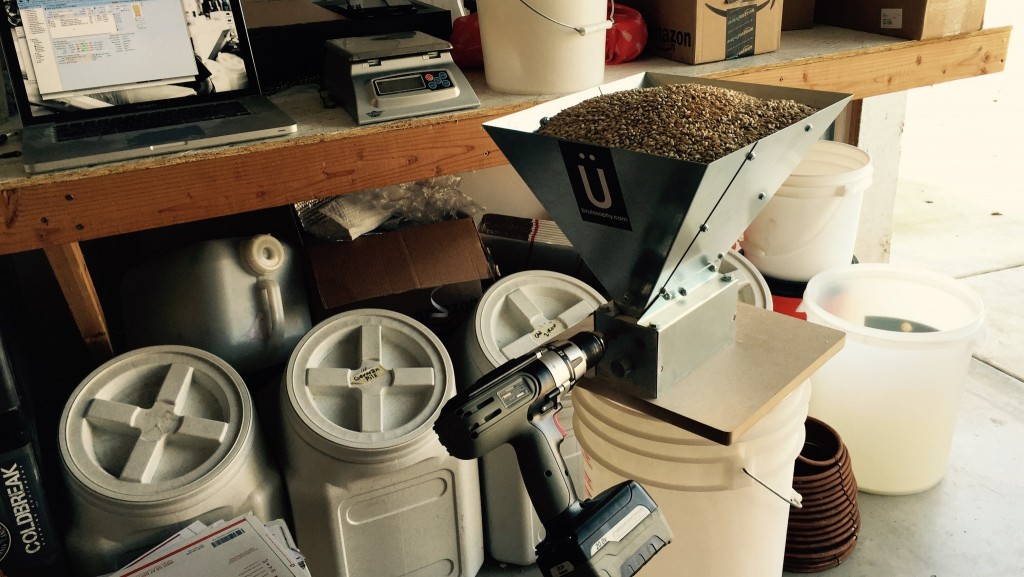
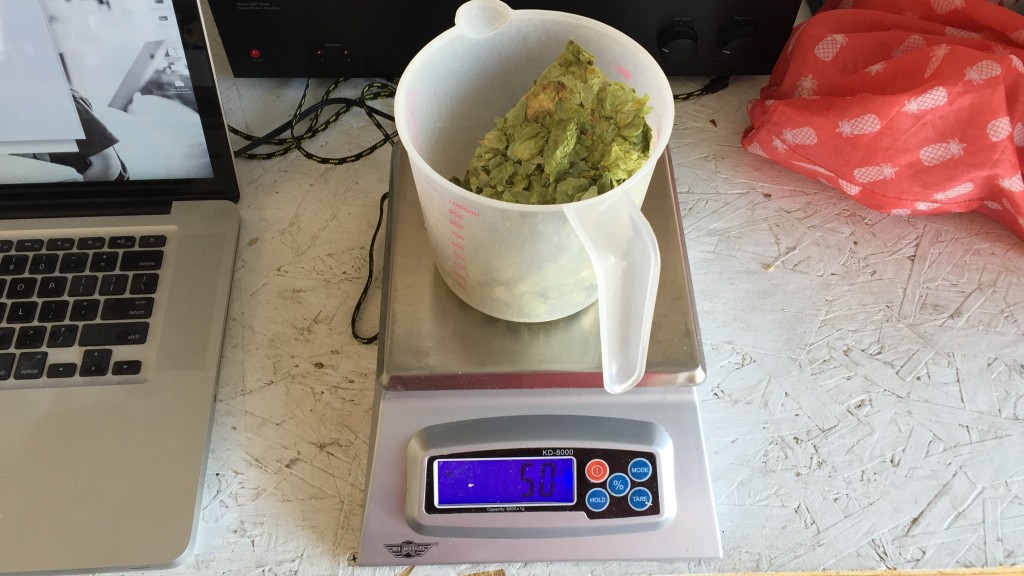
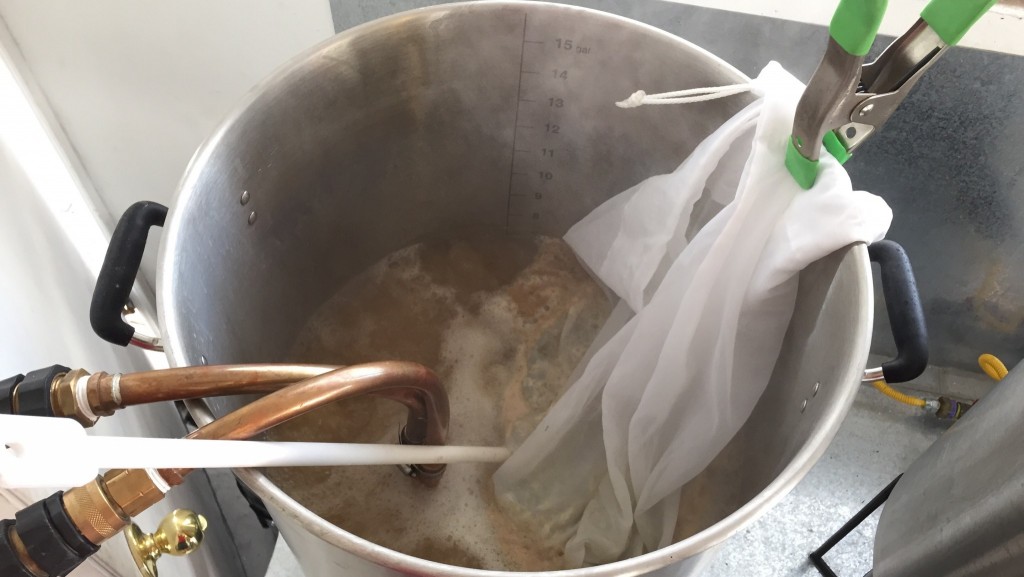
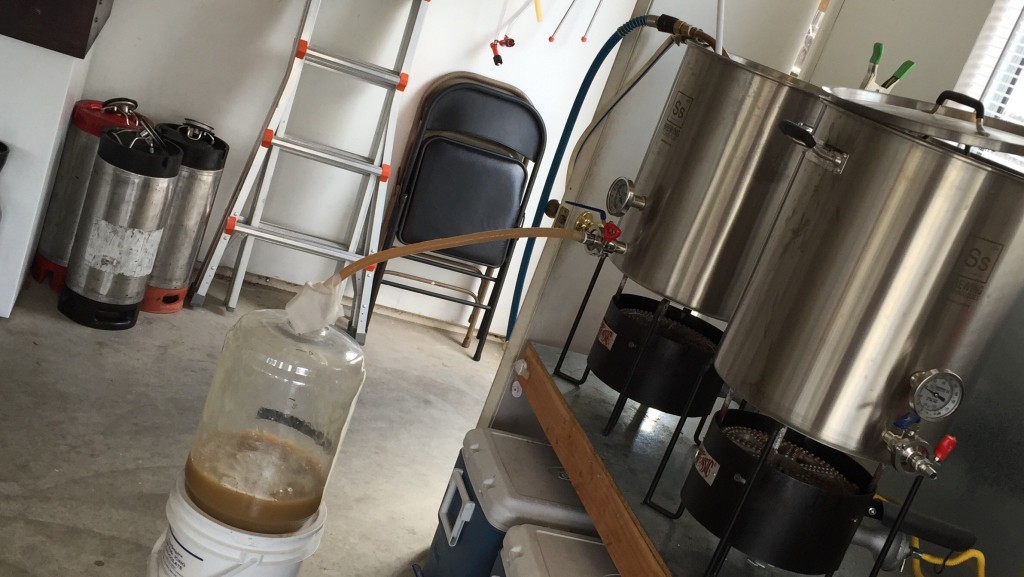
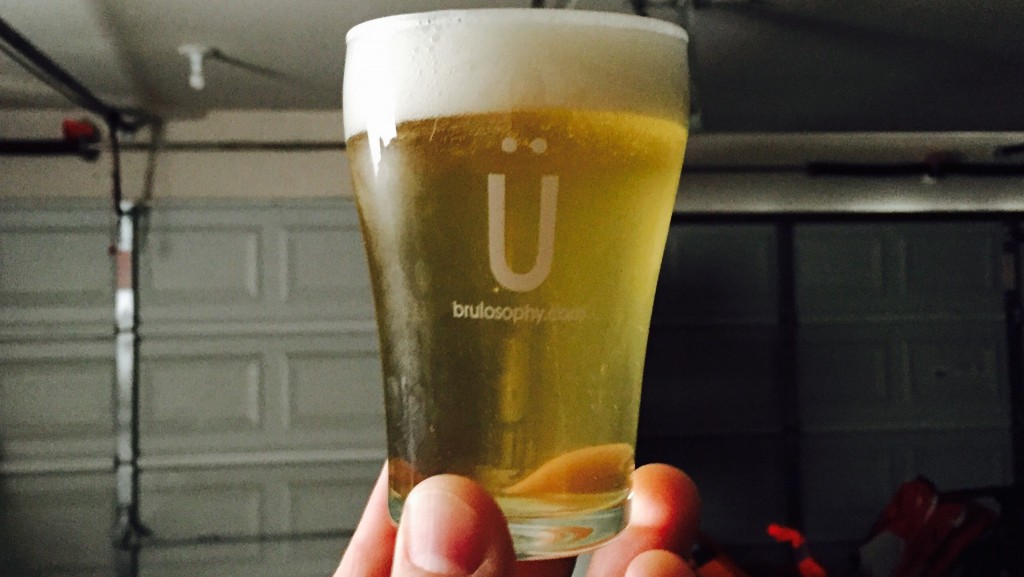










28 thoughts on “Short & Shoddy | Pilsner Malt + Denali Hops SMaSH”
Nice post. I make a beer we call 30/30 a standard american lager. 30 min mash, 30 min boil. It is much like you’ve described. Kinda thin and lifeless. But swmbo likes it. With modern fully modified malt I never get dms. No surprise to me that us05 worked fat and fine. So much oxygen and nutrients in a pack it always does.
I don’t think the lifelessness of this beer had to do with process, but the recipe.
I’d be interested in a side by side comparison of a more complex beer, even if it’s 100% Maris Otter or 2-row and some crystal malts. Two mashes, one at 15-20 minutes 1 at standard length, same with boil times 15-20min/1hr (hops adjusted for the desired bitterness), immersion chiller and hop addition at flameout/whirlpool. Call it The Tortoise And The Hare. 3 or 5gal batches are fine for this test, but it’s time you really compare this test with a recipe you expect to have depth and malt flavour.
You best tread lightly Marshall, that german facebook group is gonna put your head on a pike for such blasphemous actions LOL! ????
Amazing you can get a drinkable beer at all in such a short time! Thanks for doing this.
I’ve followed with interest your shortened mash time experiments, and as a consequence I’ve started sampling my mashes in my recirculating Grainfather with a refractometer from 45 minutes through to 90 minutes to see where it finishes. I’ve consistently found (with a range of beer styles and gravities) that I continue to get a worthwhile increase in gravity to a point somewhere between 60 and 90 minutes. So, rather than shortening my mash times, I’m actually taking them beyond 60 minutes now, unless I’m really short of time for some reason. I usually end up with 80-85% mash efficiency, sometimes higher.
Next brew I’ll try and take readings every 15 minutes from the start and graph them out. I’d expect a very sharp rise in the first 15 minutes, but I’d have thought just an extra 15 minutes would make a huge difference to the extract and would be well worth it – and still sneak in under 2 hours! There must be a lot of flavours from the malt that leach out over time in addition to the sugars converted, which would account for the lack of biscuty flavours and complexity you found in a 15 min mash.
I stole your first short and shoddy experiment and made it my new way to test out hops. With 1-gallon BIAB SMASH, it is so easy to do and gets results so quickly. Whenever I get a new hop, instead of relying on other folks’ observations, I take 45-60 minutes out of my day, a few bucks worth of grain, and make a batch so I will know for sure what I’m getting.
A couple of things:
1) I’ve been reading up on pH and water, and one thing I noted was
that for blond beers the pH should be somewhat lower, with the note
that blond beers made with a too high pH are described as flat and
lifeless, while blond beers with the correct pH come over as
crisp. So there could be definitely a relationship between the high
carbonate level in your water and this perception of your beer.
2) My tap water is also rather high in bicarbonates. The first beer I
made was done without any corrections, and it got some bitterness
(perhaps astringent, but I am a tea drinker too, so not like
that). This bitterness has mellowed over time. I suppose that the
hops you used here might mask this bicarbonate bitterness. I am
certain that it is bicarbonate bitterness, because the first thing
I did after this beer was buy a pH meter and correct my mash pH,
and none of my beers had this bitterness anymore.
Maybe you could for the next shoddy brew take the same recipe, but
also take your time to measure and correct your pH.
3) You are lucky with the DMS. This first batch I described was boiled
for 75 minutes, but I had no IC yet, and I let it cool in my
kitchen sink with the lid on. While not unpleasant, this beer
definitely has a sulfury odour to it.
Btw. I am from Belgium, so my ingredients definitely differ from
yours.
I already learned a lot from you guys, so keep up the good brewing.
Thanks for sharing. Mash time was the first process variable I messed around with, and went as low as 12m with conversion in the 70s, but I noticed the quality of the beers really wasn’t good for anything less than a 20m mash (with stirs at 0, 10,and 20m), which is my standard now. People that are getting significant gravity points after 60m might want to look at their crush.
This is great! Seems like if we adjust the recipe to include some more dextrinous malts that the short & shoddy could be even better. I often find SMaSH beers to be a little lacking. I need to try another quick brewday to see if I can improve – last time I made a simple blonde ale and it was just ‘eh’ but I think like you that had to do with recipe rather than process
Great post, love this site. Quick question though, how do you get your brew bag to sit so nicely when mashing/stirring? I have the same one you have and clamp it to the top but mine starts to twist up whenever I stir and never sits flat against the kettle.
Not sure. Likely has to do with stirring technique? I use a giant whisk to eliminate doughballs, so during the mash, I end up stirring rather gently and never have issues with a twisted sack.
“issues with a twisted sack”
Ouch!
Tell me about it.
Honestly, I’m not surprised. I brew three-gallon batches on an electric kitchen stove in a five-gallon canning pot. I don’t filter my water (though the municipal supply is good), I use a water bath to cool to pitching temperature, and I don’t have fermentation control (though I do have a corner of the house with a fairly moderate and even temperature). I do BIAB, and my mash temp has always dropped quite a bit by the end of the mash–I just wrap the canning pot in some towels for insulation.
(Side note: if 15 minutes is enough time to do the mash, its possible that the temperature drop by the end of my 60 minute mash doesn’t matter…another exbeeriment?)
My beer has consistently come out quite tasty. Not award-winning, but very good.
Keep shakin’ shit up man, I love it.
I only use my unfiltered (but tested) tap water through a garden hose, since testing this theory myself awhile ago. I’ve produced several award winning beers with this method. If the water coming out of the tap is known and viable (i.e. good brewing water), it’s not necessarily a shoddy method. Cheers, my friend!
Great stuff. My regular brew day these days is 40min mash, 30min boil, usually done and dusted by 2.5hrs. I think like you said the blandness of the beer is unlikely to have much to do with the shortened process. The small hit in efficiency is at least partially offset (cost-wise) by savings in gas/power.
Very interesting! If you were to do a more comparative study, it would be cool to make a s&s batch and “standard homebrewing principles” batch to see how far their respective character deviates. I imagine it would be hard to control the variable (for example the mash efficiency differences you observed), but the final results may have a degree of merit, Thanks for sharing; cheers!
Also, for those looking for a ~2hr brew day from start to finish, extract is a great alternative.
I’ve yet to make an extract beer I like better than AG… yeah, I’m one of those jerks.
I wouldn’t say that! Extract has its own set of difficulties, but like anything in brewing, when done right, it can produce a nice beer. I still brew extract (somewhat frequently) when I don’t have much time to brew, usually in hop bombs where I’m not looking for subtle/fresh malt characteristics. I’m also nostalgic with my beginner brewing days; cheers!
I’ve yet to taste it done right, unless I didn’t know about it. See, I’m a jerk!
lol, yeah maybe then; no worries though. cheers!
I have been very interested in fast brew days. I consistently use 15 min boils without any problems. I have experimented multiple times with short mash times (15-45 min) but wish to nail down the absolute minimum time…20min? I would not describe my last smash (2row and Merkur hop) as lifeless. In fact I found it very pleasant. In fact, this beer was brewed fast and on tap as a lager (34/70) in 11 days. Professional brewers and other BJCP judges did not notice anything wrong or off flavors and enjoyed the beer. (I am a national BJCP)
However my problem has been consistent under attenuation with short mash times! Beers taste good but only ferment 68-70% AA. It’s not my measurements, cause longer mash times will ferment dryer. Like I said the beers don’t taste sweet or off but have been finishing 1.016-1.018 with OGs in the 1.050-1.060 range. Weird….
Anyone else experienced the under attenuation? It seems like everyone still attenuates fine!
Probably the best part is Tim the neighbor. Seems like a chill dude.
One of the chillest.
> 2016
> Still fermenting US-05 at 68F
¯\_(ツ)_/¯
An idea for an xbrmnt. Short and superlative brew day versus standard brew day. So full water adjustments, 45 min mash, 30 min boil, fast chilling, correct vitality pitch v. Regular brewing methods.